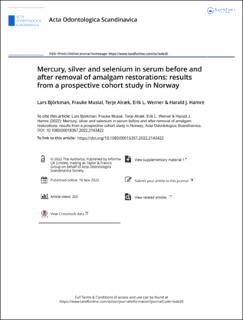| dc.contributor.author | Björkman, Lars | |
| dc.contributor.author | Musial, Frauke | |
| dc.contributor.author | Alræk, Terje | |
| dc.contributor.author | Werner, Erik Lønnmark | |
| dc.contributor.author | Hamre, Harald J. | |
| dc.date.accessioned | 2023-01-02T14:34:05Z | |
| dc.date.available | 2023-01-02T14:34:05Z | |
| dc.date.created | 2022-12-03T18:19:38Z | |
| dc.date.issued | 2022 | |
| dc.identifier.citation | Acta Odontologica Scandinavica. 2022, 1-13. | en_US |
| dc.identifier.issn | 0001-6357 | |
| dc.identifier.uri | https://hdl.handle.net/11250/3040383 | |
| dc.description.abstract | Objective A prospective cohort study on changes of health complaints after removal of amalgam restorations was carried out at the request of the Norwegian Directorate of Health. The aim was to provide and evaluate experimental treatment to patients with health complaints attributed to dental amalgam fillings. Methods Patients (n = 32) with medically unexplained physical symptoms (MUPS), which were attributed to dental amalgam restorations had all their amalgam restorations removed and replaced with other dental restorative materials. Samples of blood were collected before and 1 year after removal of the fillings, and concentration of inorganic mercury (I-Hg), methylmercury (MeHg), silver (Ag) and selenium (Se) in serum was determined by inductively coupled plasma–sector field mass spectrometry. The comparison groups (one with MUPS but without attribution to amalgam [n = 28] and one group of healthy individuals [n = 19]) received no treatment. The participants responded to questionnaires at baseline and at follow-up after 1 and 5 years. Results Concentration of I-Hg and Ag in serum decreased significantly after removal of all amalgam restorations. Concentration of MeHg and Se in serum were not changed. Intensity of health complaints was significantly reduced after amalgam removal, but there were no statistically significant correlations between exposure indicators and health complaints. Conclusions Removal of all amalgam restorations is followed by a decrease of concentration of I-Hg and Ag in serum. The results support the hypothesis that exposure to amalgam fillings causes an increase of the daily dose of both I-Hg and Ag. Even though intensity of health complaints decreased after removal of all amalgam restorations there was no clear evidence of a direct relationship between exposure and health complaints. | en_US |
| dc.language.iso | eng | en_US |
| dc.rights | Attribution-NonCommercial-NoDerivatives 4.0 Internasjonal | * |
| dc.rights.uri | http://creativecommons.org/licenses/by-nc-nd/4.0/deed.no | * |
| dc.title | Mercury, silver and selenium in serum before and after removal of amalgam restorations: results from a prospective cohort study in Norway | en_US |
| dc.title.alternative | Mercury, silver and selenium in serum before and after removal of amalgam restorations: results from a prospective cohort study in Norway | en_US |
| dc.type | Journal article | en_US |
| dc.type | Peer reviewed | en_US |
| dc.rights.holder | 2022 The Author(s) | en_US |
| dc.description.version | publishedVersion | en_US |
| cristin.ispublished | true | |
| cristin.fulltext | original | |
| cristin.qualitycode | 1 | |
| dc.identifier.doi | 10.1080/00016357.2022.2143422 | |
| dc.identifier.cristin | 2088168 | |
| dc.source.journal | Acta Odontologica Scandinavica | en_US |
| dc.source.pagenumber | 1-13 | en_US |

